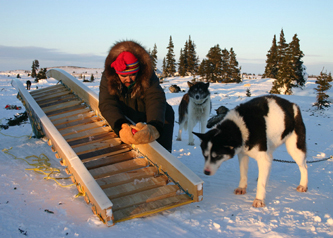Table of Contents
*
F.I.D.O.: Allen Gordon
*
Nunavik Dog Slaughters, Part I
*
Pregnancy, Whelping and Pup Development in the ISD, Part II
*
Fan Mail
*
Tip for the Trail: Building a Dog Ramp
*
In the News
*
Behavior Notebook
*
Janice Howls: Transition to Primitive
*
IMHO: Change
Navigating This
Site
Index of articles by subject
Index
of back issues by volume number
Search The
Fan Hitch
Articles
to download and print
Ordering
Ken MacRury's Thesis
Our
comprehensive list of resources
Talk
to The
Fan Hitch
The Fan
Hitch home page
ISDI
home page
Editor's/Publisher's Statement
Editor: Sue Hamilton
Webmaster: Mark Hamilton
The Fan Hitch welcomes your letters, stories, comments and suggestions. The editorial staff reserves the right to edit submissions used for publication.
Contents of The Fan Hitch are protected by international copyright laws. No photo, drawing or text may be reproduced in any form without written consent. Webmasters please note: written consent is necessary before linking this site to yours! Please forward requests to Sue Hamilton, 55 Town Line Rd., Harwinton, Connecticut 06791, USA or mail@thefanhitch.org.
This site is dedicated to the Inuit Dog as well as related Inuit culture and traditions. It is also home to The Fan Hitch, Journal of the Inuit Sled Dog.
t

With his dogs looking closely on his
work, George Annanack,
of Kuujjuaq,tunes his
sled runners during the 2005
Ivakkak Photo: Isabelle
Dubois / Makivik Corporation
Change
by Mark Hamilton
I think it's unlikely these days anybody will argue that ISD enthusiasts are just a bunch of alarmists, and the ISD in Arctic Canada is not actually endangered. The truth is, it would even be reasonable to state that the Canadian ISD is severely endangered. The number of known pure dogs is critically low and that population is geographically diffuse. For the most part, dog owners are able to keep themselves in dogs but there are not enough dogs for any large scale sharing of genetic material. In many respects the situation is like riding a bicycle in deep mud - everyone is pedaling as fast as they can, but not making much of any headway.
Moreover, in terms of the big picture, the situation has looked even worse. That's because, for the Canadian ISD's survival to have any real meaning, the breed must successfully return to its native environment. It has to be working and earning its living in sustainable numbers in the Canadian Arctic. And that environment has been increasingly unfriendly to the dogs for quite a number of years now. Without pointing fingers at any person or community, we need only take notice of places where the term "dog laws" actually means "restrictions on owning and keeping working Inuit Sled Dogs". Also notable for my purpose here are the unrestricted influx of other breeds of dogs from the south, the continuing problem of dogs lost to preventable diseases and the fact that the breed's perilous situation goes largely unacknowledged by the local, regional and national governments.
I've heard Bill Carpenter, John McGrath and Ken MacRury all assert that, "the future of the ISD is in the Arctic". I understand what they are saying. I don't disagree. What ISDI is accomplishing right now is the equivalent of keeping a bowl of sour dough starter for someone else: care for it, feed it, use it, and keep it alive. But we cannot be the breed's ultimate future. If we are, sadly, it's already over for the ISD in Arctic Canada.
That short list catalogs a few of the major challenges the Canadian ISD faces. Let's look beyond those problems for a moment. In emergency situations, once the "dust" has settled, one of the first orders of business is to catalog all available resources. So what have we got?
We've got dogs, we've got visibility, and we've got us. That last item, "us" is very significant. "Us" is a much larger number now than it was when ISDI started seven years ago. We span the globe, both hemispheres including the northern polar region.
Lately, occurrences in Nunavik have added to this list of resources. The annual Ivakkak sled dog race, sponsored by Makivik Corporation, added language to its rules and regulations stating that the dogs should be the "dogs of our ancestors" and went on to list many physical characteristics describing those dogs. Also, as you will read elsewhere in this issue of The Fan Hitch, Allen Gordon has embarked on a personal effort to establish a team of pure ISDs in his home community of Kuujjuaq, with the hope that his effort will be the start of the popularization of once again keeping the pure dogs in Nunavik. And finally, as you will also read elsewhere in this issue of The Fan Hitch, Makivik Corporation is making a serious effort aimed at calling for a formal investigation of the events of the 1950s, 60s and 70s commonly referred to as “The Dog Slaughters”.
Allen has taken affirmative action in the best interest of the Inuit Sled Dog. Makivik Corporation is now centrally involved in issues of sled dogs past and present. The way I see it, the environment in Nunavik just became a whole lot more sled dog friendly. With new friends, new allies and a new prospective beginning in the Canadian North we could be on the verge of something big for the Inuit Sled Dog.
I think that bicycle is starting to move forward.